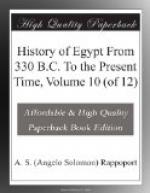At this time the Greeks in Egypt were beginning to follow the custom of their Egyptian brethren, to take upon themselves monastic vows, and to shut themselves up in the temples in religious idleness. But these foreigners were looked upon with jealousy by the Egyptian monks as intruders on their endowments, and we meet with a petition addressed to Philometor by Ptolemy, the son of Glaucias, a monk in the temple of Serapis at Memphis, who styles himself a Macedonian, complaining that his cell had been violently entered and himself ill-treated because he was a Greek; and reminding the king that last year, when the king visited the Serapium, he had addressed the same petition to him through the bars of his window. The priests in temples of Egypt were maintained, partly by their own estates, and partly by the offerings of the pious; and we still possess a deed of sale made in this reign by the Theban priests, of one-half of a third of their collections for the dead who had been buried in Thynabunum, the Libyan suburb of Thebes. This sixth share of the collections consisted of seven or eight families of slaves; the price of it was four hundred pieces of brass; the bargain was made in the presence of sixteen witnesses, whose names are given; and the deed was registered and signed by a public notary in the city of Thebes. The custom of giving offerings to the priests for the good of the dead would seem to have been a cause of some wealth to the temples. It was one among the many Egyptian customs forbidden by the law of Moses.
From this deed of sale we also gain some knowledge of the state of slavery in Egypt. The names of the slaves and of their fathers are Koptic, and in some cases borrowed from the names of the gods; hence the slaves were probably of the same religion, and spoke nearly the same language as their masters. They sunk into that low state rather by their own want of mind than by their masters’ power. In each case the slave was joined in the same lot with his children; and the low price of four hundred pieces of brass, perhaps about thirty-eight dollars for eight families, or even if it be meant for the half of eight families, proves that they were of the nature of serfs, and that the master, either by law or custom, could have had no power of cruelly overworking them. On the other hand, in the reign of Philadelphus, the prisoners taken in battle, who might be treated with greater severity, were ransomed at fifteen dollars each. We see by the monuments that there were also a few negroes in the same unhappy state of slavery. They were probably not treated much worse than the lowest class of those born on the soil, but they were much more valuable. Other slaves of the Berber race were brought in coasting vessels from Opone on the incense coast, near to the island of Dioscorides.




